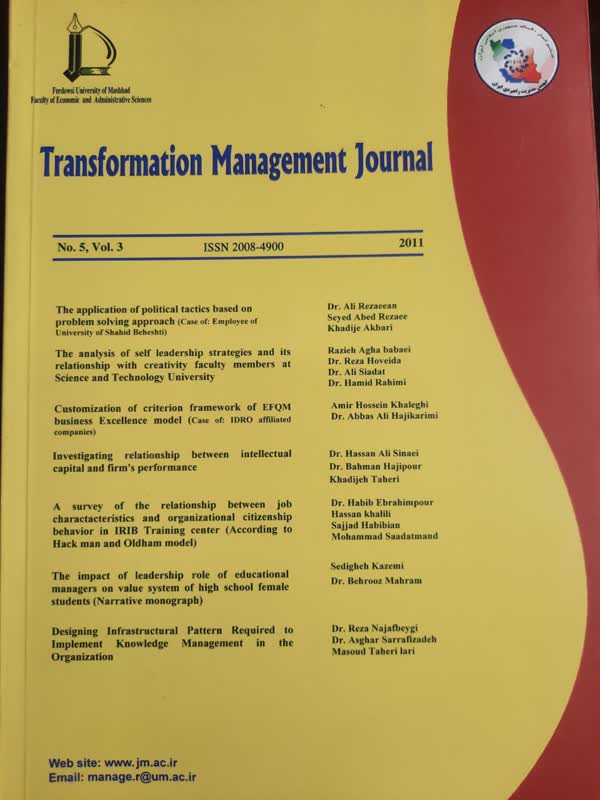Document Type : Articles
Author
Abstract
European Foundation for Quality management (EFQM) Business Excellence model as a holistic management tool for Corporate Performance Measurement and Self improvement is a prevalent assessment approach in today's organizations. Criterion weights' structure of EFQM Excellence model is one of the constituted elements of the excellence model. This research investigates the weights' structure of EFQM Excellence Model with Data Triangulation approach, and eventually suggests a customized framework of Criterion weights for organizations within the Research population. Research data was collected through a survey of 52 Iranian Companies from IDRO affiliated Companies. Survey data was analyzed by means of Factor score regression based on Confirmatory Factor Analysis on 500 Bootstrapped samples. The analysis showed that perceived weights of enabler criteria are not inconsistent with current weight allocation of the EFQM enablers but this is not the case for the Results, consequently perceived weight structure vary from the EFQM weight structure. However, perceived weights of Enabler Criteria are significantly different from those of Result criteria.
Keywords
- Bou-Llusar, J. C.; Escrig-Tena, A. B.; Roca-Puig, V. & Beltran-Martın, I. (2009). An empirical assessment of the EFQM excellence model: Evaluation as a TQM framework relative to the MBNQA model. Journal of Operations Management,
27, 1-22.
- Brown, T. A. (2006). Confirmatory factor analysis for applied research. New York: The guilford press.
- Conti, T. A. (2007). A history and review of the European quality award model. TQM Magazine, 19(2), 112-128.
- Davis, J. (2008). Integration: Is it the key to effective implementation of the EFQM excellence model? International Journal of Quality and Reliability Management, 25(4), 383-399.
- EFQM. (2010). Radarise your business for success. Brussel: EFQM publications.
- Efron, B. & Tibshirani, R. (1993). An introduction to the bootstrap. London: Chapman & Hall.
- Eskildsen, J. K.; Kristensen, K. & Juhl, H. J. (2000). The causal structure of the EFQM excellence model. Proceedings of the 1st international maaoe conference on organizational excellence. Estes park.
- Eskildsen, J. K., Kristensen, K. & Juhl, H. J. (2001). The criterion weights of the EFQM excellence model. International Journal of Quality and Reliability Management, 18(8), 783-795.
- Eskildsen, J. K.; Kristensen, K. & Juhl, H. J. (2002). Trends in EFQM criterion weights, The case of denmark 1998-2001. Measuring Business Excellence, 6(2), 22-28.
- Grigg, N. P. & Mann, R. S. (2008). Rewarding excellence: an international study into business excellence award processes. The Quality Management Journal, 15 (3), 26-40.
- Hakes, C. (1997). The corporate self assessment handbook (2nd Ed.). London: Chapman and Hall.
- Hardjono, T. & de Klein, P. (2003). Introduction on the european corporate sustainability framework (ECSF). Journal of Business Ethics, 55 (2), 99-113.
- Hughes, O. E. (2003). Public management and administration. Boston: Twayne Publishers.
- Kennerley, M. & Neely, A. (2003). Measuring performace in a changing business environment. International Journal of Operations & Production Management, 23 (2), 213-229.
- Krejcie, R. V. & Morgan, D. W. (1970). Determining sample size for research activities. Educational & Psychological Measurement, 30, 607-610.
- Kristensen, K., Juhl, H. J. & Eskildsen, J. K. (2001). Benchmarking excellence. Measuring business excellence, 5(1), 19-24.
- Kristensen, K., Juhl, H. J. & Eskildsen, J. K. (2004). Private versus public sector excellence. The TQM Magazine, 16(1), 50-56.
- Loomba, A. P. & Johannessen, T. B. (1997). Malcolm baldrige national quality award, Critical issues and inherent values. Benchmarking for quality management and technology, 4(1), 59-77.
- Najmi, M. & Hosseini, S. (2004). EFQM excellence model (2003 version), from idea to practice. Tehran: Ronas Publishers (in Persian).
- Neely, A., Adams, C. & Crowe, P. (2001). The performance prism in practice. Measuring business excellence, 5(2), 6-12.
- Porter, L. & Tanner, S. (2004). Assessing business excellence (2nd ed.). Boston: Elsevier Butterworth-Heinemann.
- Shao, J. & Tu, D. (1995). The jackknife & bootstrap. New York: Springer-Verlag.
- Simons, R. (1994). Levers of control: how managers use innovative control systems to drive strategic renewal. Boston: Harvard business school press.
- Westerveld, E. (2003). The project excellence model: linking success criteria and critical success factors. International Journal of Project Management, 21 (6), 411-418.
- Wongrassamee, S.; Gardiner, P. D. & Simmons, J. E. (2003). Performance measurement tools: the balanced scorecard and the EFQM excellence model. Measuring Business Excellence, 14-29.

Send comment about this article